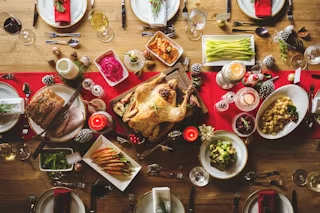
All over the world, families and friends sit down together for Christmas dinner. They share laughter and stories over a table laden with food and drink, often recipes that have been passed down for years.
Even though families, cultures, and countries have different traditions, we wanted to walk you through some of the most common dishes seen on American holiday tables and share some of the stories that made them popular!
Drinks and Cocktails
Eggnog
Who doesn’t love a creamy glass of eggnog? This boozy drink is based on cocktails made out of milk and wine in 17th century England. It was often used to toast the health of party-goers.
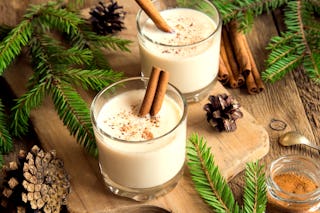
Wassail
Wassail is a drink made of wine, fruit juices, and winter spices that came about in England as a way to celebrate the New Year. Eventually, it made its way into colonial America. The master of each household would drink to the health of those in the house, then pass the drink around. Everyone would say, “Wass Hael”, which means “Be Well.”

Main Courses
Christmas Goose
A beautiful, roasted goose is the epitome of Christmas tradition! Though not as common today, it’s still often eaten for Christmas dinner.

Geese mature towards the end of the year when they’re fat after feasting on fallen corn, which makes them perfect to eat for Christmas! They were first used as a centerpiece during the winter solstice feast in the Middle Ages, as well as in Greek culture to ensure good crops.
Roast Turkey
Though turkey is often thought of for Thanksgiving, it’s also eaten in many American households for Christmas. Turkey took the place of the Christmas goose for American settlers because it was readily available. and also matured at the end of the year. They were easily because they’re big enough to feed a lot of people and didn’t serve an important function like laying eggs or producing milk.

Christmas Ham
The smoked ham originated in Tudor England, where the wealthiest families featured a roast boar head as the centerpiece of their Christmas dinner. The idea came from the Norse god of harvest and fertility, who was associated with boars. It’s eaten for Christmas in cultures all around the world!

Side Dishes
Green Bean Casserole
Green bean casserole is an American staple at Christmas dinner! And it originated from (where else?) Campbell’s. The famous brand used to print recipes on their vegetables and, in 1955, a woman named Dorcas Reilly had her “green bean bake” published. It gained popularity quickly because it was made using things Americans already had in their pantries. Soon people were asking Campbell’s for the recipe!

Cranberry Sauce
Because cranberries are one of the few fruits that are native to North America, it was only natural for colonists to tie them into their food. But the sweet, cranberry sauce that we know today didn’t become popular until the 19th century. And, in the early 20th century, farmers started to grow cranberries in bogs instead of dry-harvesting, which made the fruit (and the sauce!) much more commonplace!

Mashed Potatoes
Who doesn’t love creamy, buttery mashed potatoes? Americans certainly do! As early as 1747, they began mashing up potatoes with butter and cream. Potatoes are easy to grow, filling, healthy, and affordable – it’s clear to see why these are a classic!

Stuffing (or Dressing)
Is it stuffing or dressing? Well, it’s stuffing when cooked inside the bird and dressing when cooked separately.
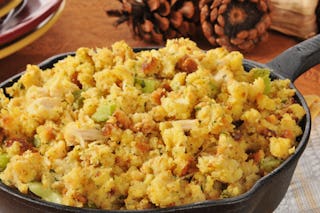
As early as the 1st century, people were stuffing animals with nuts, vegetables and herbs. But in the 1970’s, Stovetop Stuffing became popular and more and more people began cooking it separately, for ease. And, of course, the South makes cornbread dressing!
Sweet Potatoes
Sweet potatoes themselves originated in South and Central America and were brought over from Europe. They flourish in the humid climates of the South, so Southerners began using them instead of pumpkin in pies and sides.
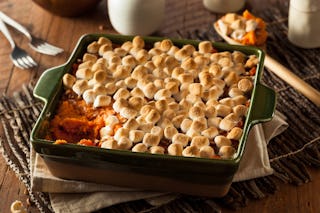
In the 1900’s, they appeared for the first time baked with marshmallows in a cookbook commissioned by one of the first companies to mass produce (what else?) marshmallows!
Dinner Rolls
The classic “Parker house roll” that we think of originated in the Boston Parker House Hotel in the 1870’s. An angry hotel baker threw unfinished rolls into the oven after an argument with a guest. They came out fluffy on the inside and crispy on the outside! And, of course, they’ve been a favorite ever since.

Sweets and Treats
Fruitcake
Generally, you either love or hate this recipe! It was derived from the British Christmas pudding, which was steamed cake flavored with dried fruit. It was easy to make for Americans with fruit they had dried in their pantry and lasts a long time, making it a popular dish for early Christmases.
Christmas Cookies
Christmas cookies date back to the Middle Ages, where spices like cinnamon and nutmeg were just starting to be widely used. Only around holidays could people afford to bake with commodities like sugar, so they took advantage of that at Christmas.
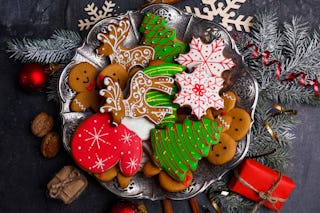
Cookies were often a favorite because they could be easily shared with family and friends! And many Christmas cookies today still use spices like cinnamon and nutmeg.
Pumpkin Pie
The original pumpkin pie didn’t look much like the one we bake today! In the colonies, Americans would use a hollowed out pumpkin shell and fill it with milk, honey, and spices and would bake that in hot ashes.

In fact, pumpkins were some of the gifts brought to the first settlers from Native Americans! Over time, pumpkin pie came to be baked in a crust and became what we know and love today.
Apple Pie
The classic American apple pie actually originated in 1381 England, where they baked apples, figs, raisins, and pears in a pastry shell.
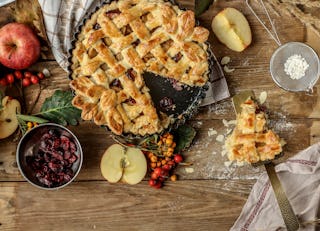
In the 1500’s, they started including sugar and, when the colonists arrived in America, it only made sense to use the crab apples they found to bake pies.
Gingerbread
Ginger was known for its health benefits and was seen in gingerbread form around 2400 B.C. During the middle ages, hard cookies were cut into shapes (animals, kings, and queens) and decorated.

Gingerbread houses became popular in Germany in the 16th century, prompted by the famous fairytale, Hansel and Gretel. And the soft gingerbread that we often see today started in America, when George Washington’s mother served her famous recipe, which spread throughout the country.